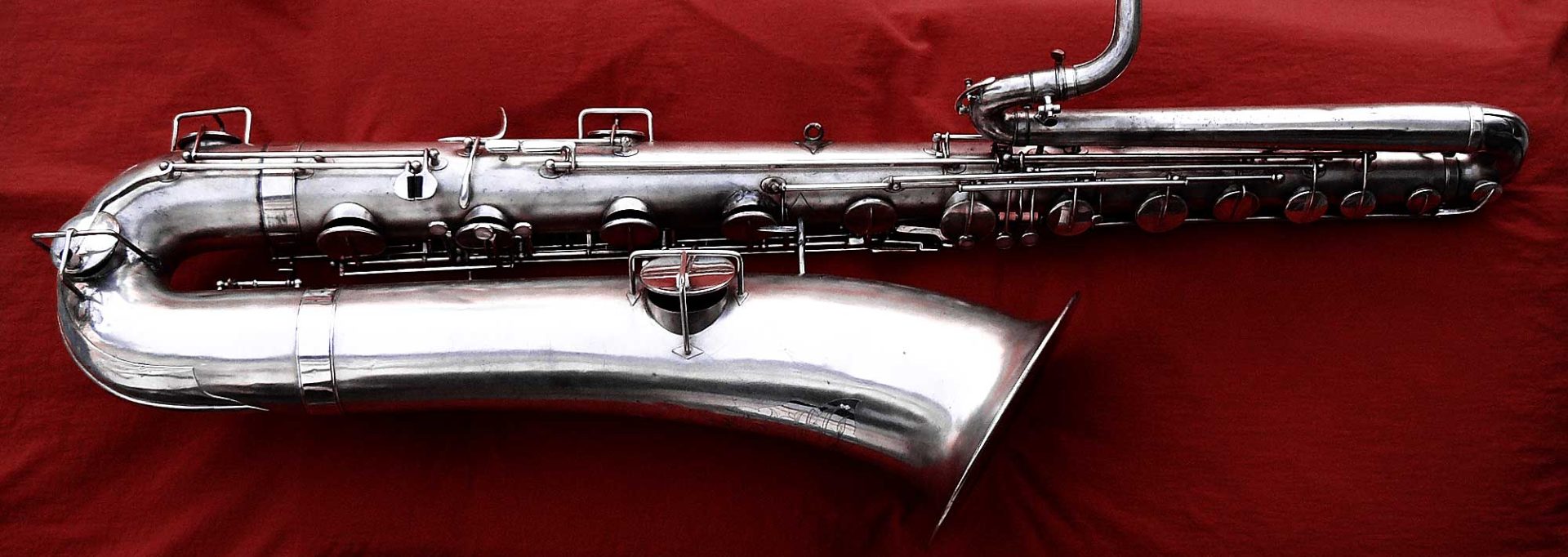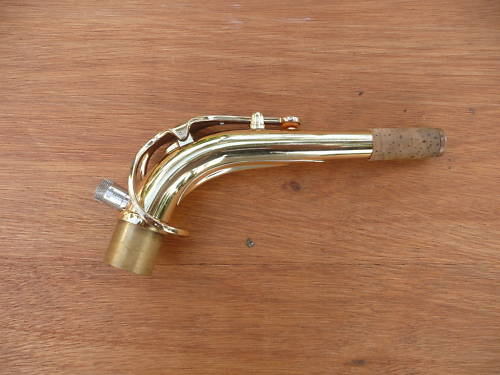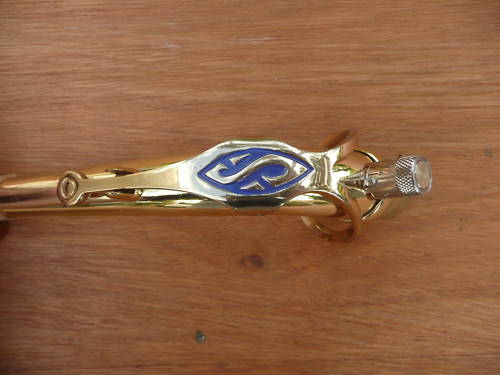Has anyone ever heard of a harmonic neck by Selmer? A seller from France is selling one on eBay and claims that it is rare and original.
Source: eBay.com
I looked through close to 5,000 images of Selmer necks on Google, but didn’t see anything that even came close to resembling this. Now Google does say that there are about 33,600 results for Selmer saxophone neck. Perhaps had I persevered I might have seen something similar around page 5,000 of Google images, but honestly, I had lost interest at by page 200 already.
Here is how the seller describes this unusual item:
RARE VINTAGE SELMER “HARMONIC” NECK FOR ALTO SAX
Rare vintage SELMER neck for alto saxophone, special model for “harmonics” notes!
Good general state.
More details and pics on ask.
Sep 11, 2010
Q: is it factory made?
A: Yes. Thanks for looking.
Source: eBay.com
Source: eBay.com
Has anyone here seen anything like it? It appears that there is a patent stamp on the little plug in the photo above. Perhaps the plug itself is patented, but not the way it is inserted into the neck?
This little plug looks familiar to me somehow. I’ve seen something similar somewhere—not on a saxophone neck—unfortunately I can’t remember where. Does anyone have any ideas?
Speaking of ideas, does anyone have any ideas what model of Selmer alto this neck is from? I want to go with Mark VI, but I may be totally off base. I’m not familiar enough with modern Selmers to be able to accurately ID a neck from one when I see it in isolation.
The auction for this harmonic Selmer alto neck runs until September 15. Bidding is to start at $300.00. Perhaps not surprisingly, no one has bid on it yet, because I am likely not the only one scratching their head about its authenticity.






When I heard “Harmonic,” I immediately thought of the S80 horns with the “Harmonic” neck. The neck you’re talking about looks considerably different, though.
My opinion is that it’s not a Selmer attachment. It’s a real Selmer neck, of course, but that metal wart/knob ….
My second thought was that this was a Varitone or other pickup. I’ve looked over Selmer’s patent drawings and the very, very detailed account of the Varitone at http://www.tcgakki.com/fair/27.html (use Chrome to translate) and I don’t think it’s that, either, nor do I think it’s an Octavoice pickup. I still think it’s probably a pickup of some kind, though. To be completely certain, I’d think the best thing would be to ask if there’s a patent number on it. I can see “Pat …” in one of the pics and that’s it. (Unless, of course, it was put in by a person named “Pat” :P.)
I also did a brief search of Selmer patents and didn’t see anything that looked like this attachment.
The other question was, “Which Selmer is this neck for?” I can’t give you a conclusive answer on that, either, but I think it’s for a VI: the VII and S80 *more often* had an engraving/stamp on the “front” of the neck under the key.
Hi Pete,
That’s an interesting conjecture, that it could be a prototype for some sort of pickup. I can easily imagine it as an improvised binding post for a piezo transducer.
The “spoiler” comment, BTW, was not entirely toungue-in-cheek. The patented device appears to have a plunger through the knob, and the calibration might refer to the depth that wahtever is on the inner end of the piston protrudes into the bore of the neck.
Meanwhile, I’ve thought of a way that this could be a patch for a functional speaker vent. The necessary linkage could be fastened to a piece of square stock anchored in the hole for the music lyre holder for testing purposes.
That’s an interesting varitone setup, particularly in regard to this discussion. The pickup location is just about where a true altissimo vent should be, near the cork. I wonder if that has any influence on the altissimo response? And for those who prefer to cap, fill or patch that hole in the neck, perhaps this is an opportunity to experiment with such a vent.
You’ve described in a more direct way what I observed. The slab of brass I called a “rounded triangle” is the place where the model info is often stamped, as you more clearly stated.
Peace,
paul
WordPress misses a lot of non-English characters. No worries.
I’m not familiar with oboes or how they vent, so I’m not clear on how this type of vent wouldn’t affect the rest of the notes if it’s open all the time.
I’m not in the best head space today. A very close friend just died (see today’s blog post), and I’m operating on very little sleep. We had a show last night and I didn’t get home until 2:00, so I’m only partially functioning at the moment. I’ve been up since 7:00.
I’ll send the email to Pete now while I have some time and ask him to pop in here this weekend while he’s got a bit of time.
Hey Helen,
It looks like wordpress doesn’t like my botched Latin, eh?
Speaking of which, I just had a thought (uh-oh, look out!)
Maybe what we’re looking at is a Santy Runyon style spoiler for the neck. :devil2:
*ducks*
I call shenanigins–maybe.
My curiosity piqued, I did a little digging and uncovered a thread at SOTW that discusses the Selmer Harmonic Series of saxes. This post indicates that they were made available for the Series III:
http://tinyurl.com/2bu34qt
A subsequent post attests to at least one example of a Mark VII Harmonic and suggests there *might* have been prototypes during the Mark VI run:
http://tinyurl.com/2fdhnq9
Sure enough, these galleries of what appear to be promotional material appear on the SaxPics web site:
http://www.saxpics.com/?v=gal&a=1706
http://www.saxpics.com/?v=gal&a=1707
Please note two things: 1) The vent appears to the side of the neck, not on the back where the linkage to it would have been obstructed by the neck socket tightening screw; 2) The vent is located between the standard vents, not closer to the mouthpiece.
Considering the first point, the only way this vent could be functional as it appears in the eBay listing would be if it were linked by cable to a key on the body of the sax.
The second point is more telling. Despite the marketing „Mist“ [I suspect only Helen shall appreciate that pun], this vent is obviously designed to improve the response at the upper end of the range from written E5 to A#5. Taking a small digression, the oboe has much in common acoustically with the saxophone. Long ago oboe makers had sorted out the need for at least 3 vents to properly support the range from written C#5 to G6. The first, supporting C#5 to D#5, is opened with the index finger of the left hand; the second, supporting E5 to A#5, by the thumb; and the third, supporting B5 and above, by the side of the index finger or through an automatic mechanism that requires only the thumb. The location of vent pictured above corresponds well with that of the second vent of an oboe.
Here is an example that demonstrates both the true altissimo vent and cable linkage, the Benedikt Eppelsheim Eb contrabass saxophone:
http://www.eppelsheim.com/eb_kontrabass_saxophon.php?lang=en
There are some Mark VI necks that are easily identified by photo. Some of the early VIs have a matching s/n stamped on the tenon. Unfortunately, there are a number of Mark VII necks that are indistinguishable from later Mark VI necks. Identifying the neck in the eBay listing is further confounded by the lack of a rounded triangle on the back of the neck just above the tenon which might have provided a visual clue to its age. In passing, the lacquer color is suspicious, IMHO, compared to what I have seen of Mark VIs with original lacquer.
Given the evidence, it is highly doubtful that what is pictured in the eBay listing is what it is claimed to be. However, there exist instruments that use a linkage mechanism that solves the technical problems, and who really knows what goes on in the Selmer “Skunk Works”, so I suppose it could be possible.
Peace,
paul
I finally had a chance to take a serious look at all the links and information you provided… (I’ve been so snowed under with stuff all week it’s been nuts.)
What jumps out at me right away is that all the Selmer altissimo vents are attached to keys and have mechanisms. This piece of equipment doesn’t. This appears to be open all the time. Or, perhaps if it is twistable, then it might have an open/shut option. Either way, it doesn’t seem all that practical.
I’ve been meaning to ask Pete Hales to look at this, but I keep forgetting. I’ll do so over the weekend, and perhaps he might be able to offer up some insights.
I’m not convinced it’s authentic, but you never know…
To clarify, contrary to the marketing „Mist“, a vent in the location indicated by the pictures from the eBay listing and promotional materials could *theoretically* facilitate the emission of the notes in the written ranges G6-A6, G7-A7, and D7-E7 for a saxophone. In that sense, it could be described as an “altissimo vent”. The primary use of such a vent in this location to facilitate the emission of notes in the written range of E5-A#5 is well-established in the fabrication of members of the oboe family, which have a number of similarities with saxophones regarding the shape of the bore and the diameter and placement of holes.
OOPS 😳
The ranges should read “F6-A7, F7-A8, and C7-E7”.
Sorry for the fl?tum cer?br? :devil2:
Update: There were no takers at $250 either. I guess no one believed the seller that this was an authentic Selmer rarity.
Update: This Selmer supposed original oddity did not sell either time around on eBay. When the 1st time around it didn’t sell for $300, the seller re-listed it for $250. Still not takers. So far it has not reappeared.
I think the problem is that no one has seen anything like it before, and that there is no explanation given as to what it really does. I don’t know if language is a barrier for the seller, but perhaps a better description and explanation might go a long ways in aiding sell this rather unusual Selmer alto neck.
Helen, are you talking to your experts to figure if this is legit?